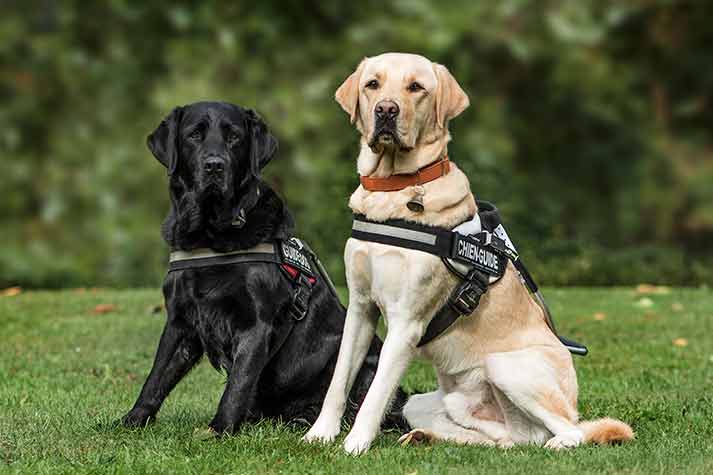
15 May
Roles of Service, Working, Therapy Dogs & Support Animals
Dogs have lived alongside mankind for centuries. From hunting and herding to guarding and guiding, the roles they play have evolved with us. More than just helpers or livestock, they are loyal and cherished companions now.
Today, the spectrum of working dogs includes service animals, therapy dogs, emotional support animals (ESAs), and purpose-trained working dogs. While all are valuable, each serves a distinct purpose and is recognized differently under the law.
Here’s A Breakdown of Their Various Roles
Service Dogs: Trained for Independence
Service dogs are highly trained animals that help individuals with disabilities navigate daily life. A service dog is typically defined as one that has been individually trained to perform tasks directly related to a person’s disability. This includes physical, sensory, psychiatric, intellectual, or other mental impairments.
Common examples include:
- Guide Dogs: Assist individuals who are blind or visually impaired.
- Hearing Dogs: Alert deaf individuals to key sounds, such as doorbells or alarms.
- Mobility Dogs: Help people with physical disabilities by opening doors, retrieving items, or offering physical support.
- Psychiatric Service Dogs: Trained to detect symptoms of psychiatric distress, such as anxiety attacks, and interrupt or mitigate them.
- Autism Support Dogs: Help manage overstimulation or repetitive behaviours in individuals on the autism spectrum.
- Seizure Alert Dogs: Trained to detect or respond during a seizure episode, offering protection or seeking help.
Legal Rights of Service Dogs
In countries like the USA, service dogs are granted full public access rights. They can accompany their handlers into restaurants, stores, public transportation, and even housing where pets are otherwise not allowed. Airlines must accommodate them, though each carrier has its own protocols; usually requiring the dog to remain at the handler’s feet or lap and stay out of the aisles or emergency exits.
Working Dogs: Task-Oriented and Mission-Driven
Working dogs are bred and trained for specialized jobs beyond aiding individuals with disabilities. These dogs perform operational roles and often serve alongside military, police, or emergency personnel.
Types of working dogs include:
- Search and Rescue (SAR) Dogs: Deployed in natural disasters, missing persons cases, or mass casualty events. Bloodhounds are commonly used for their scent-tracking abilities.
- Explosives Detection Dogs: Trained to identify explosives in airports, military zones, and public venues. Breeds like German Shepherds and Belgian Malinois are favored for their discipline and drive.
- Cancer Detection Dogs: Labradors have been trained to identify cancerous samples by scent; sometimes with accuracy exceeding that of standard diagnostic tests.
- Allergy Alert Dogs: Alert handlers to the presence of allergens such as peanuts or gluten in their environment, often used by children in schools.
Unlike service dogs, working dogs typically do not have public access rights unless actively engaged in duty. When they are working, it is crucial that they are not distracted or touched by the public.
Therapy Dogs: Providing Comfort Where It is Needed Most
Therapy dogs are not trained to help one individual. Instead, they work with their handler (often a volunteer) to bring comfort and emotional support in structured environments such as hospitals, schools, or nursing homes.
What sets therapy dogs apart is their temperament. These dogs are calm, gentle, and remain at ease in unfamiliar surroundings. They are chosen for their sociability and ability to handle unpredictable situations without stress or snapping. Their presence can ease pain, reduce anxiety, and even promote recovery.
Therapy Dog Guidelines and Limitations
Therapy dogs are not considered service animals under the ADA, which means they do not have the right to enter public spaces where pets are prohibited. Most therapy dog programs are administered by non-profits, which provide training, testing, and liability insurance.
The American Kennel Club’s Canine Good Citizen (CGC) program is often a required stepping stone before entering a therapy dog program.
Emotional Support Animals: Comfort at Home
Unlike service or therapy dogs, emotional support animals (ESAs) are not required to undergo specialized training. Their role is to provide companionship and emotional comfort to individuals struggling with mental health conditions such as depression, anxiety, PTSD, or phobias.
To be recognized as an ESA, the owner must obtain a formal letter from a licensed mental health professional stating the animal’s role in supporting their condition. These animals do not perform specific tasks, which is why they are not recognized as service dogs under the ADA.
ESA Rights and Limitations
Emotional support animals have limited legal protections. While they are not allowed in all public places, housing laws under the Fair Housing Act allow them in “no pet” properties when proper documentation is provided. However, as of 2021, airlines are no longer required to treat ESAs as service animals, meaning most are now subject to pet fees and carrier restrictions during flights.
Know the Difference & Respect the Role
While the lines between these categories might blur in casual conversation, legally and functionally they are distinct. Service dogs are protected by law and perform essential tasks tied to a disability. Working dogs perform mission-based duties for organizations or agencies. Therapy dogs offer emotional support in shared settings, while emotional support animals provide companionship at home.
Understanding the differences helps us respect the boundaries these dogs need to do their jobs and appreciate the sheer number of ways they make our lives better.






AUTHOR’S BIO
Carry My Pet
Passionate pet enthusiasts and globetrotters, dedicated to easing furry friends' journeys worldwide. Penning tales of compassion at CarryMyPet, where every relocation is a tail-wagging adventure.